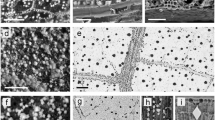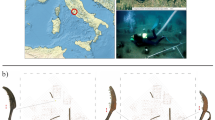Abstract
ALTHOUGH considerable work has been done on the cell wall structures of ancient and buried woods1 and their degradation2 from chemical, physical and botanical aspects3, little attention has so far been paid to the differential behaviour of the main tissues of such woods. While studying the minute anatomy of fossil woods and buried woods, we noted the peculiar behaviour of the two important tissues of the dicotyledonous woods. During long submersion of wood in water or soil, parenchyma cells and rays are usually found to retain their original structure better than the fibres (Fig. 1). This was reported by two of us (K. A. C. and S. S. G.), but no definite reason for such behaviour could be put forward except the nature of pits on the walls of fibres, vertical parenchyma cells and wood rays4. The main obstacle to chemical investigation has so far been the difficulty of obtaining pure samples of parenchyma and fibres from fresh woods. Recently, while working on bamboo, it has been possible to separate mechanically its parenchymatous and prosenchymatous tissues. This led us to think that it might be worth while analysing chemically these pure tissues and at the same time examining them microscopically at different stages of delignification, with the view of getting a clearer picture of the nature of the cell wall.
This is a preview of subscription content, access via your institution
Access options
Subscribe to this journal
Receive 51 print issues and online access
$199.00 per year
only $3.90 per issue
Buy this article
- Purchase on Springer Link
- Instant access to full article PDF
Prices may be subject to local taxes which are calculated during checkout
Similar content being viewed by others
References
Bailey, I. W., and Barghoorn, E. S., Pap. Peabody Found. Arch., 2, 82 (1942). Muller-Stoll, W. R., “Mikroskopie des Zersetzten und fossilisierten Holzes”, in “Handbuch der Mikroskopie in der Technik”, 5, pt. 2 (1952). Varossieau, W. W., in Beekman, W. B., “Hout in alle tijden”, 1/5, 331 (1949); English summary.
Barghoorn, E. S., Pap. Peabody Found. Arch., 4, 49 (1949). Bot. Mus. Leaflets, Harvard Univ., 14, 1 (1949); “Sedimentary Petrology”, 22, 34 (1952).
Jahn, E. C., and Harlow, W. M., Pap. Peabody Found. Arch. 2, 90 (1942). Sen, J., Bot. Rev., 22, 343 (1956).
Chowdhury, K. A., and Ghosh, S. S., Proc. Nat. Inst. Sci. India, 12, 440 (1946). Ghosh, S. S., Ancient India, 6, 18 (1950). Chowdhury, K. A., Abstract. VII Int. Bot. Cong., Sect. Palseobot Stockholm (1950).
Author information
Authors and Affiliations
Rights and permissions
About this article
Cite this article
CHOWDHURY, K., GHOSH, S., BHAT, R. et al. Difference in the Behaviour of Tissues in Ancient Plant Remains and during Chemical Treatment. Nature 180, 612–613 (1957). https://doi.org/10.1038/180612b0
Issue Date:
DOI: https://doi.org/10.1038/180612b0
This article is cited by
-
Chemische und elektronenmikroskopische Untersuchung eines fossilen Fichtenholzes
Holz als Roh- und Werkstoff (1971)
-
Untersuchungen an einer alten Holzprobe
Holz als Roh- und Werkstoff (1958)
Comments
By submitting a comment you agree to abide by our Terms and Community Guidelines. If you find something abusive or that does not comply with our terms or guidelines please flag it as inappropriate.



